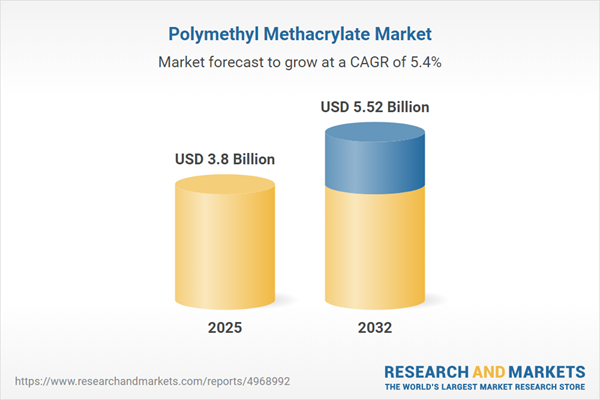Speak directly to the analyst to clarify any post sales queries you may have.
Polymethyl methacrylate (PMMA) is a versatile engineering thermoplastic renowned for its clarity, strength, and adaptability across industries. With rapid shifts in technology adoption, regulatory frameworks, and sustainability initiatives, this market is evolving into a focal point of material innovation and supply chain optimization.
Market Snapshot: Polymethyl Methacrylate Market
The global polymethyl methacrylate market grew from USD 3.61 billion in 2024 to USD 3.80 billion in 2025. Looking ahead, it is expected to expand at a compound annual growth rate (CAGR) of 5.42%, reaching USD 5.52 billion by 2032. This growth is fueled by rising demand for lightweight, impact-resistant materials, regulatory focus on sustainability, and continuous innovation in polymer processing techniques. Sector-wide demand is being shaped by applications in automotive, construction, electronics, and healthcare, with distinct momentum coming from architectural glazing, advanced optical devices, and flexible electronic displays.
Scope & Segmentation
- Manufacturing Techniques: Casting for premium clarity, extrusion for large-scale sheet production, and injection molding for high-volume, complex components.
- Material Forms: Pellets and granules for efficient molding; sheets and films for broad coverage and specialized end-uses.
- Applications:
- Barriers and enclosures for safety and sound control
- Display units including LCD and OLED screens
- Lenses for solar concentration and optics
- Skylights in both aerodynamic and flat formats for buildings and vehicles
- End-Use Industries: Automotive (components, lighting, windshields), construction (acrylic shapes, facades, security glazing), electronics (display panels, lens modules), and healthcare (dental equipment, medical devices).
- Regional Coverage:
- Americas: United States, Canada, Mexico, Brazil, Argentina, Chile, Colombia, Peru
- Europe, Middle East & Africa: United Kingdom, Germany, France, Russia, Italy, Spain, Netherlands, Sweden, Poland, Switzerland, UAE, Saudi Arabia, Qatar, Turkey, Israel, South Africa, Nigeria, Egypt, Kenya
- Asia-Pacific: China, India, Japan, Australia, South Korea, Indonesia, Thailand, Malaysia, Singapore, Taiwan
- Key Companies Analyzed: 3A Composites GmbH, Asahi Kasei Corporation, Kuraray Co., Ltd., Makevale Group, LOTTE Chemical Corporation, Sumitomo Chemicals, Evonik, LG Chem Ltd., Daeson, Mitsubishi Rayon Co., Ltd.
Key Takeaways for Decision-Makers
- Sustainability is driving the adoption of bio-based monomers and recyclable PMMA, especially in regions with strict environmental mandates.
- Technological advancements such as UV-curing and additive manufacturing are enabling new design possibilities, supporting customized solutions for medical and optical devices.
- Localized manufacturing is gaining ground as companies mitigate geopolitical risks and logistics bottlenecks, particularly in response to evolving global trade conditions.
- Automotive and electronics manufacturers are accelerating their pursuit of lightweight and ultra-thin components, aligned with efficiency and advanced display requirements.
- Collaboration along the value chain, including cross-sectoral partnerships, is critical for meeting both performance and regulatory criteria.
- Industry leaders are investing in closed-loop recycling and digital platforms to optimize process efficiency and align with circular economy objectives.
Tariff Impact and Supply Chain Adaptation
The implementation of revised United States tariffs in 2025 has intensified global supply chain complexity for polymethyl methacrylate. Higher import duties on precursors and finished goods have prompted suppliers to redirect trade flows, prioritizing Asia Pacific and Middle Eastern markets with favorable agreements. North American manufacturers are navigating fragmented sourcing while ramping up investments in nearshore production hubs to buffer against volatility. Logistics models and pricing strategies are being recalibrated across the value chain to preserve margins and ensure continuity.
Methodology & Data Sources
This report applies a rigorous research methodology combining primary interviews with industry stakeholders, regulators, and analysts, alongside secondary analysis of technical publications, association reports, and company disclosures. Data validation and triangulation strengthen the reliability and depth of market segmentation, while ongoing engagement with industry participants ensures up-to-date intelligence.
Why This Report Matters
- Enables senior leaders to benchmark competitive positioning and prioritize growth segments with confidence.
- Offers a clear, actionable roadmap for supply chain resilience, regional strategy, and sustainable material innovation.
- Delivers specialized insights into technology trends, regulatory impacts, and collaborative opportunities that drive long-term value.
Conclusion
The polymethyl methacrylate market is evolving through concurrent shifts in technology, trade, and sustainability. Stakeholders who align operational excellence with innovation and collaboration will be best positioned to shape the future of this dynamic market landscape.
Additional Product Information:
- Purchase of this report includes 1 year online access with quarterly updates.
- This report can be updated on request. Please contact our Customer Experience team using the Ask a Question widget on our website.
Table of Contents
3. Executive Summary
4. Market Overview
7. Cumulative Impact of Artificial Intelligence 2025
Companies Mentioned
The companies profiled in this Polymethyl Methacrylate market report include:- 3A Composites GmbH
- Asahi Kasei Corporation
- Kuraray Co., Ltd.
- Makevale Group
- LOTTE Chemical Corporation
- Sumitomo Chemicals
- Evonik
- LG Chem Ltd.
- Daeson
- Mitsubishi Rayon Co., Ltd.
Table Information
| Report Attribute | Details |
|---|---|
| No. of Pages | 184 |
| Published | November 2025 |
| Forecast Period | 2025 - 2032 |
| Estimated Market Value ( USD | $ 3.8 Billion |
| Forecasted Market Value ( USD | $ 5.52 Billion |
| Compound Annual Growth Rate | 5.4% |
| Regions Covered | Global |
| No. of Companies Mentioned | 11 |









